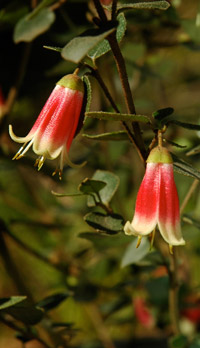SUMMER FLOWERS IN THE GARDENS
Summer blooms have an appeal all their own, from fiery reds to cool creamy whites. Enjoy the colours and textures as you discover the beauty and diversity of Australia's plants.
Here we feature some flowers you can see this summer in the Gardens that may also inspire you to add colour to your Garden at home.
These plants are available in select nurseries and from Australian Native Plants Society Canberra Region sales at the Gardens in spring and autumn.
Information provided by Ros Walcott.
Blandfordia grandiflora Christmas Bells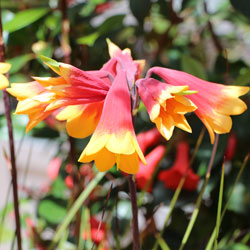
Blandfordia grandiflora has very large waxy red bells tipped with yellow, held on wiry stems above grass-like foliage. The leaves grow to 30cm high and the flower stems can rise to 80cm.
Blandfordia grandiflora grows naturally in moist sandy soils in New South Wales and Queensland.
They attract nectar feeding birds, butterflies and other insects.
SEE Blandfordia grandiflora IN FLOWER IN THE GARDENS this summer in Section 221 in a pot near the Visitor Centre or Section 191 in the Sydney Region Gully.
GROW IT AT HOME Blandfordia grandiflora make wonderful container plants as they are long lived and require nothing more than regular watering and some occasional fertilizer. They are more tricky to grow in gardens where they need full sun to light shade and moist, well-drained sandy soils. A similar plant like is Calostemma purpureum or Garland Lily, but it flowers after Christmas from January to March.
Image: Ben Walcott
Actinotus helianthi or Flannel Flower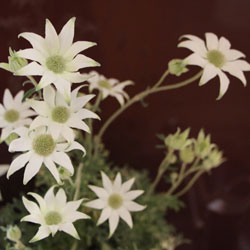
Actinotus helianthi has white star flowers with yellow grey centres and silver-grey divided foliage. They grow naturally from south-central Queensland to NSW.The variety ‘Federation Star’ can be seen commonly in the Gardens where it has self-seeded.
SEE ACTINOTUS HELIANTHI IN FLOWER IN THE GARDENS this summer in the Rock Garden section 15c, section 191s of the Sydney Region Gully and Section 174 between the main concourse and the carpark.
GROW IT AT HOME Flannel Flowers can be grown in full sun or partial shade and tolerate light frost once established. They are shallow rooted plants that require good drainage. They have relatively high fertiliser requirements and respond well to tip pruning after flowering.They can be brittle so require protection from strong winds. Flannel Flowers make excellent pot plants.
Image: Ben Walcott
Ceratopetalum gummiferum or NSW Christmas Bush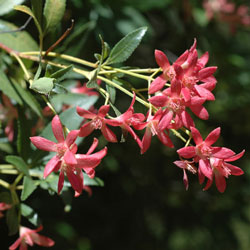
Visitors to the Australian National Botanic Gardens are pleasantly surprised to find New South Wales Christmas Bush Ceratopetalum gummiferum thriving in Canberra and still red in late autumn.
Like Bougainvillea and Poinsettia the petals are not the brightest part of the plant; in these plants the calyx lobes enlarge after flowering and are highly coloured. However, in Ceratopetalum gummiferum the flowers also are attractive; soft cream clusters over the light green glossy foliage.
Flowers open from December onwards in Canberra and as each one dies its calyx enlarges and turns red and papery, looking like four or five petals. The colour is a warm carmine*, uncommon among native plants at this time.
This species is endemic to New South Wales where it occurs along the coast. There are no other large Australian natives that provide such a show at Christmas although Lilly Pilly (Syzygium varieties) can provide flushes of crimson new growth.
SEE CERATOPETALUM GUMMIFERUM IN FLOWER IN THE GARDENS this summer on the sheltered rocky slopes of section 191 of the Sydney Region Gully and in the Rainforest Gully sheltered by trees or other shrubs.
GROW IT AT HOME This tall shrub or small tree is popular in cultivation owing to its bright red calyces at Christmas time. Canberra gardeners can confidently plant this species in almost any soil or situation desired except that open to strong winds, which would spoil the foliage. It reaches about 6 m high, though in its native habitats it can be 10 m.
A number of horticultural selections (cultivars) have been made of Ceratopetalum gummiferum and these are usually available from specialist nurseries. They may vary from the 'natural' plant in leaf colour or in the size and colour of the 'flowers'.
Image: APII
Viola hederacea or Native Violet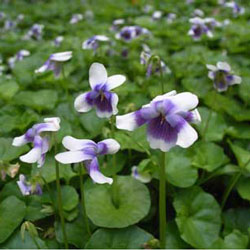
Viola hederacea is a small mauve and white native violet that creates a dense ground cover. It flowers profusely most of the year, but especially June to March with delicate flowers.
It is common and widespread in Queensland, New South Wales, Victoria, Tasmania and South Australia.
SEE VIOLA HEDERACEA IN FLOWER IN THE GARDENS this summer in sections 15a in the Rock Garden and in Section 142 of the Tasmanian section.
GROW IT AT HOME Viola hederacea grows best in a partly shaded position in moist soil. This plant is considered suitable to use in rockeries, hanging baskets, pots, mass plantings, and ground cover works to make any surrounding more attractive.
Other plants like this are Pelargonium rodneyanum, Pelargonium australe and Viola betonicifolia.
Image: APII
![Director of National Parks [logo]](../../images/dnp_90px.gif)





